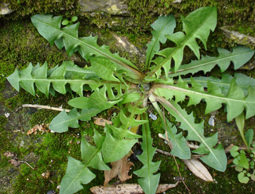
 Photo by Rick Gush |
With the recent rains, the weeds around here are jumping again. But that’s mostly good news for us because we really like to eat the local wild greens mix. The group of weeds that are harvested here in Liguria are called preboggin (pray-boo-zhawn). It’s unusual in that it is both a traditional food for poor people and now a prized delicacy in fancy local restaurants.
This mix of young leaves from a group of about 30 plant species is used like spinach in cooked dishes such as vegetable pie and stuffed ravioli and is often mixed with potatoes and green beans. Of the 30 or so collectable species, each harvester finds a slightly different mix, so the composition of preboggin is variable. The group includes a few species like curly dock, sorrel, cats-ears and milkweeds but is largely made up of a bunch of different dandelion cousins. All of the perhaps twelve dandelion types in preboggin are in the Taraxacum genus. I think this entire genus produces young leaves that are used in cooking.
 Photo by Rick Gush |
The first picture is of one of my favorite dandelions; the tagginetti. (I’m horrible at Italian spelling, as my wife will attest, so this could perhaps actually be spelled taeginetti or something similar.) The leaves are a bit small, being only three or four inches long, but where tagginetti are growing, the leaves are plentiful. The severely jagged edges make this edible leaf the easiest to recognize when one is out in the field picking greens.
The second photo is of the second most common component of preboggin, and that is the milkweed. There are two or three types of milkweed on the preboggin list, and they are particularly vigorous and opportunistic growers, and they produce nice big leaves. The stems and flowers are not eaten, but the succulent new leaves are plucked off. These plants have flowers like dandelions, except they are on two foot tall stems.
I’ll confess, I’m not sure the scientific name of what I’m calling milkweed. They are not Asclepias. I think they are just another branch of the Taraxacum genus. When I was wandering the woods as a kid and eating all the edible plants, this is one that I missed eating. Because the stems exude a milky sap when broken, I always thought milkweeds were slightly poisonous, but instead they are delicious!




